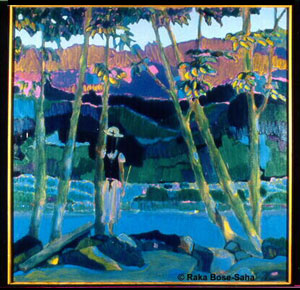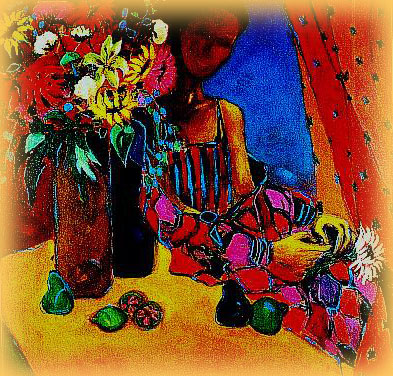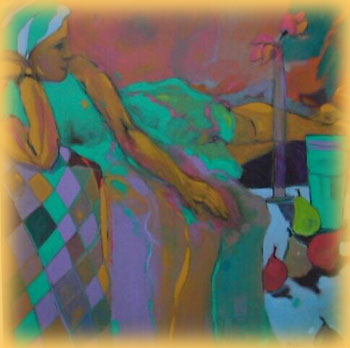RAKA B. SAHA: ART & ARTIST VERITÉ
Robert
J. Lewis
It is no small distinction to be chosen to appear in Best of Watercolor, by Rockport Publishers, a publication that acknowledges only the very best of North America's water colorists. That the honor has thus far not translated into any significant commercial or popular success comes as no surprise to Raka B. Saha, who is a committed 'representational' artist. But genuinely unconcerned as she is about lack of recognition, she is steadfast in her determination to confront certain basic truths about the human condition as we approach the 21st century.
 In
canvases exploding with exotic vegetation and prodigious color, Saha's art
marks a radical departure from post-modernism, which, as a movement, is unique
in the history of painting in that the sum of its meanings is subjectively
generated by the viewer -- not the artist. Saha's highly particularized leitmotifs
are fashioned to engage and persuade, gathering their energy and purpose from
deep beneath the surface of her work to finally appear as reminiscences of
places and priorities lost in the rush to modernity: leaving no doubt that
this is an artist who has something to say and makes sure you know what it
is!
In
canvases exploding with exotic vegetation and prodigious color, Saha's art
marks a radical departure from post-modernism, which, as a movement, is unique
in the history of painting in that the sum of its meanings is subjectively
generated by the viewer -- not the artist. Saha's highly particularized leitmotifs
are fashioned to engage and persuade, gathering their energy and purpose from
deep beneath the surface of her work to finally appear as reminiscences of
places and priorities lost in the rush to modernity: leaving no doubt that
this is an artist who has something to say and makes sure you know what it
is!
It is through a delicious accumulation of natural serenities that tweak the heart and stir our humanity that Saha forcefully establishes her signature and style. And if her predominantly water-based colors seem to have been conceived to disarm and soothe, one suspects that this result has been won only after a prolonged struggle to finally bring to light a rich inner world of unexpressed feeling and emotion. 'Unfairly' reducing her work to a single vision, it is laid bare in her powerful invocations of longed for places for which we no longer have time.
Born in Calcutta, Raka B. Saha has lived in St. Louis and now works as an artist in Atlanta, Georgia. But it is Calcutta that excites the imagination and informs her palette. She says that despite the city's legendary poverty, exotic flora, vivid color and sunlight are almost preternaturally abundant.
 If
her landscapes seem to be quite bursting with color, it is not an accident
that we don't find even a hint of ostentation or self-indulgence. In the hands
of a lesser artist, these canvases could have easily become fruitless exercises
in over-statement, but Raka B. Saha practices a restraint to the effect that
her colors brim without spilling. And where people occasionally appear, their
proportions are agreeably small against the immensity of nature, suggesting
an emerging calm and quietude: as sprawling roots, rivers, ponds and sunsets
are intertwined, so it is with man and nature.
If
her landscapes seem to be quite bursting with color, it is not an accident
that we don't find even a hint of ostentation or self-indulgence. In the hands
of a lesser artist, these canvases could have easily become fruitless exercises
in over-statement, but Raka B. Saha practices a restraint to the effect that
her colors brim without spilling. And where people occasionally appear, their
proportions are agreeably small against the immensity of nature, suggesting
an emerging calm and quietude: as sprawling roots, rivers, ponds and sunsets
are intertwined, so it is with man and nature.
At a deeper level, Saha's landscapes betray a powerful nostalgia, or hunger for communion with alternative environments that are beyond 'practical' reach. In many of the superb "Forest Fantasy" series of paintings, root systems are left exposed, inviting gaps in dense growth fill with sunsets or flowered fields or dappled water; but these sacred spaces seem most reserved for the artist, herself, who enters them with an intensity that must equal the foreboding grays and long shadows cast by the cityscape that has been her life-long home. In language that communicates before it is understood, Saha's art completely rejects the urban landscape, the finality of which suggests the invisible presence of an exorcist driving the creative impulse -- to expel the psychic damage done by the city.
It's virtually impossible to stand before works such as "Nature's Fanfare" or "The Shaded Garden" without being drawn into the enchanted but very real localities the imagination replicates in an attempt to harmonize the conflicting claims made by the various orders of reality. And we happily submit because the eye, as the measure of the artist's carefully considered composition, cannot stand still, but delights in exploring every nook and cranny in order to discover and recover what has been lost. Unlike the fantasy/naif art that emerged in Yugoslavia under Tito, Saha's art is real, and her preferred places are real choices.
Tactile, sun-baked, and deepened with calm and healing are the definitive characteristics of Saha's remarkable colors. Her use of yellow, in particular, is bold and original, mixed with sun, wind and monsoon. Applied with utmost discretion, it illuminates and enlivens many of her landscapes, as in a flowing mustard field glimpsed through a forest, or a molten sunset set against a silhouette of delicate foliage. More the stuff of substance than color, the yellow is nuanced and adaptable, and conceived to reveal movement, dimension and specificity.
 In
her figure work, which is not as startling as her landscapes, the subjects
are not so much expressive of human emotion as devices upon which color can
be brought to bear; and of course the human body has always been a vehicle
for form, which can be as unaffectedly graceful as the curve of a back, or
the shape of a knee. In "Enigmatic Variation," a woman is reclining
beneath a blanket that is almost living tissue, her bony knees bent and depicted
in a daring new aesthetic. Through the power of the artist's imagination and
execution, the knee-and-leg, deformed according to conventional categories
of seeing, is somehow transformed into a limb that commands our attention.
In
her figure work, which is not as startling as her landscapes, the subjects
are not so much expressive of human emotion as devices upon which color can
be brought to bear; and of course the human body has always been a vehicle
for form, which can be as unaffectedly graceful as the curve of a back, or
the shape of a knee. In "Enigmatic Variation," a woman is reclining
beneath a blanket that is almost living tissue, her bony knees bent and depicted
in a daring new aesthetic. Through the power of the artist's imagination and
execution, the knee-and-leg, deformed according to conventional categories
of seeing, is somehow transformed into a limb that commands our attention.
As with all noteworthy art, Saha's work fills a void where none had been thought to exist, with an idiom that speaks to the ever widening breach between spirit and progress.
In an age where sham art (minimalism and installation art) abounds, and is irresponsibly abetted by art critics such as The Globe & Mail's reigning Pope of art criticism, John Bentley Mays, Raka B. Saha restores our faith in the painstaking process and commitment (and risk) required of significant art.
Raka B. Saha's works are on display at Galerie d'Arts Contemporains, rue Crescent,
Montreal, Quebec.
THE END